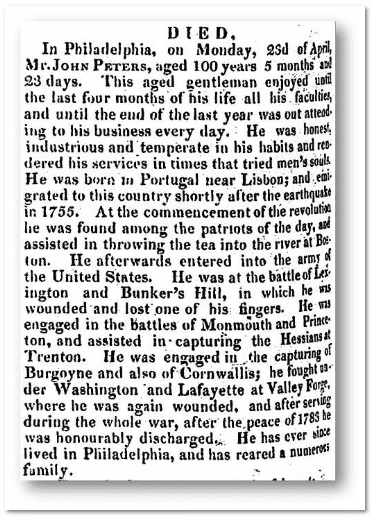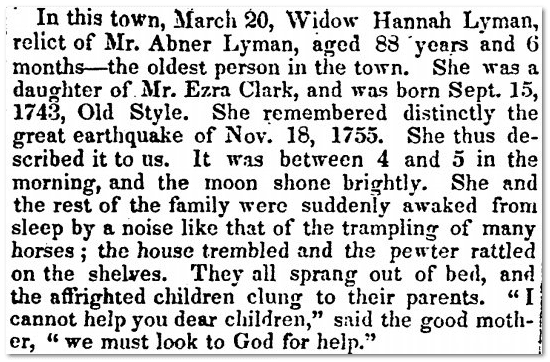You can learn a lot about the Americans who fought in our country’s wars—from the Colonial Indian Wars down to the conflicts in Afghanistan and Iraq—from GenealogyBank’s online newspaper archives.
Revolutionary War Hero Lives to Be a Centenarian
This old obituary gives us many details of the life of John Peters, a Portuguese American who fought in the Revolutionary War and lived to be over 100 years old. It was published in the Alexandria Gazette (Alexandria, Virginia), 1 May 1832, page 2.
Peters was there from the beginning of the troubles with Great Britain.
He was at the Boston Tea Party on 16 December 1773. He then joined the army.
During the American Revolutionary War he fought in the Battle of Lexington and the Battle of Bunker Hill.
Although Peters “lost one of his fingers” in that latter battle, he continued to fight for his new country.
He was “in the battles of Monmouth and Princeton, and assisted in capturing the Hessians at Trenton.”
The historical obituary of this old Revolutionary war soldier goes on to say “He was engaged in the capturing of Burgoyne and also of Cornwallis; he fought under Washington and Lafayette at Valley Forge, where he was again wounded.”
It tells us he was “aged 100 years 5 months and 23 days” when he died on 23 April 1832. That calculates out to give us his birth date: 31 October 1731.
And just where was this centenarian veteran born? The old newspaper obituary tells us that he was born “in Portugal near Lisbon.”
 Earthquakes That Shook the World in 1755 Remembered
Earthquakes That Shook the World in 1755 Remembered
The veteran’s obituary adds the extra detail that he “emigrated [sic] to this country shortly after the earthquake in 1755.”
According to Wikipedia that was the 1755 Lisbon earthquake, “one of the deadliest earthquakes in history” with tens of thousands killed.
There were several powerful earthquakes in 1755. Another one was the Cape Ann earthquake that hit the U.S. 18 days after the Lisbon earthquake, on the northeast coast of Massachusetts.
Young Hannah Clark [Hannah (Clark) Lyman (1743-1842)], then a child of 12, was terrified by the Cape Ann earthquake. Her obituary clearly recorded her terror at living through that earthquake.
It was published in the Hampshire Gazette (Northampton, Massachusetts), 21 March 1832, page 3.
“She remembered distinctly the great earthquake of Nov. 18, 1755…It was between 4 and 5 in the morning, and the moon shone brightly. She and the rest of the family were suddenly awaked from sleep by a noise like that of the trampling of many horses; the house trembled and the pewter rattled on the shelves. They all sprang out of bed, and the affrighted children clung to their parents. ‘I cannot help you dear children,’ said the good mother [Martha Phelps Clark, 1717-1803], ‘we must look to God for help.’”
According to Wikipedia this was “the largest earthquake in the history of Massachusetts.” Cape Ann and Boston felt the brunt of the earthquake’s aftermath; however hundreds of homes and buildings throughout the state of Massachusetts were also damaged. Northampton, Massachusetts, is 142 miles from Cape Ann, Massachusetts.
These two powerful earthquakes were so memorable that 77 years later they were mentioned in these 1832 obituaries.
Don’t let the stories of your ancestors’ lives be lost. Use GenealogyBank to find them and document their lives.




